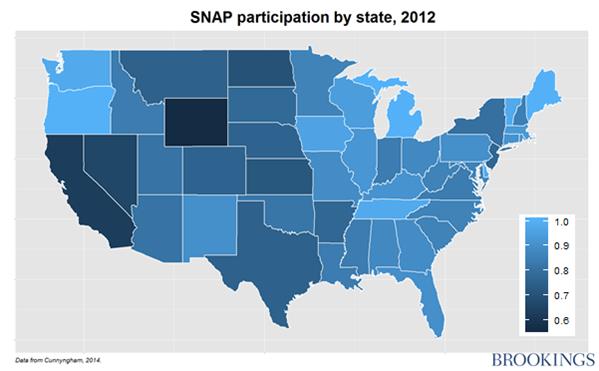Washington abounds with ideas for fighting poverty.
President Obama and many Democrats want to raise the minimum wage. The Children’s Defense Fund has a raft of suggestions, from expanding housing subsidies and creating subsidized jobs to fully-refundable tax credits. Other progressives are calling for an expansion of benefits under Social Security.
But a new study by the Brookings Institution argues that it might be a lot easier to significantly reduce poverty in the U.S by getting more people to take advantage of existing anti-poverty programs for which they are already eligible.
Related: Why So Many Americans Are Trapped in ‘Deep Poverty’
In fact, the report asserts, the poverty rate would have been 20 percent lower in 1998 if all families with children had participated in the programs for which they were eligible, and “deep poverty”– income below half the federal poverty level –would have been 70 percent lower.
“Sometimes the best policy is [simply] to make existing programs reach further, rather than inventing new ones,” wrote Richard V. Reeves, policy director of Brookings’ Center on Children and Families, and Edward Rodrigue, a research assistant.
The report – drawn from a recent Urban Institute analysis of data– offers some intriguing insights to the gross underutilization of a handful of vital government anti-poverty and social safety net programs. Among them: the National School Lunch Program, the Supplemental Nutrition Assistance Program (SNAP), the Earned Income Tax Credit, and the Women, Infants and Children (WIC) nutrition program.
According to the latest data, 17 percent of those eligible for both the school lunch program and food stamps (SNAP) don’t enroll in those programs; 20 percent of Americans eligible for the Earned Income Tax Credit don’t sign up; and fully 37 percent of mothers and children who are entitled to take part in WIC have not enrolled.

So why don’t more people participate in these programs? Reeves and Rodrigue say it seems unlikely that so many people don’t take part because of personal preferences or access to other forms of support – such as church, community or local government services.
Related: The Surprising Fact of Hunger in America
“More likely they struggle to overcome obstacles that stand in the way of receipt,” they wrote.
The reasons are varied: A 2001 New York State report cited long office wait times (27 percent of respondents waited over an hour to recertify their eligibility), trouble finding or paying for transportation, difficulty taking time off from work and childcare issues among the most common reasons for non-participation.
One reason not mentioned in the study but likely a factor is pride and embarrassment over having to stand in line to apply for social services. Some people just don’t want to do that. Or they may feel uncomfortable with others knowing that their children are participating in government-subsidized school breakfast and lunch programs.
Related: Obamacare Creates a Two-Tiered Medicaid System
Finally, variations in geography contribute to differing participation rates in these programs. For instance, the vast majority of people eligible for food stamps in Maine, Oregon and Michigan were enrolled compared with just 56 percent in Wyoming. EITC participation rates also vary, though less dramatically. Oregon had a take-up rate of 73.4 percent, while 84.5 percent of eligible filers claimed the credit in Mississippi. .
The study doesn’t offer a specific explanation for these regional variations, but one would have to assume they go to such matters as the distance an eligible person has to travel to apply for benefits, access to transportation – especially in the wide-open spaces of the West and Southwest—and socio-economic norms and attitudes.

So what can be done to boost the participation rates? According to the Brookings report, a number of relatively modest reforms could help a lot.
One innovation already is being used. Schools in low-income neighborhoods can now provide free meals for all their students to avoid missing some needy children – and making all the children feel more comfortable about accepting the meals.
And states could streamline WIC and SNAP applications to reduce the frequency of recertification. Also, outreach efforts might also prove to be effective.
Related: Poverty Moves Into the Burbs
“Together, these improvements could have as significant impacts as a new safety net program,” the Brookings report said..
The administration of former President George W. Bush offered a prime example of what could be accomplished with a little effort. Bush was eager to get the participation rate in the food stamp program up. The solution, officials found, was to simplify the income and expense reporting requirements, lengthen the certification periods, harmonize eligibility across the programs and for the first time offer the ability to begin applications online or by phone.
The net result was that SNAP’s participation rate rose from 54 percent in 2001 to 69 percent in 2007 – then finally 83 percent in 2012. For sure, some of that increase in eligible Americans was due to economic downturns, such as the Great Recession, that drove more low-income people to seek assistance. But the Bush innovations proved to be highly effective – and helpful for some of the country’s neediest Americans.
Top Reads from the Fiscal Times





